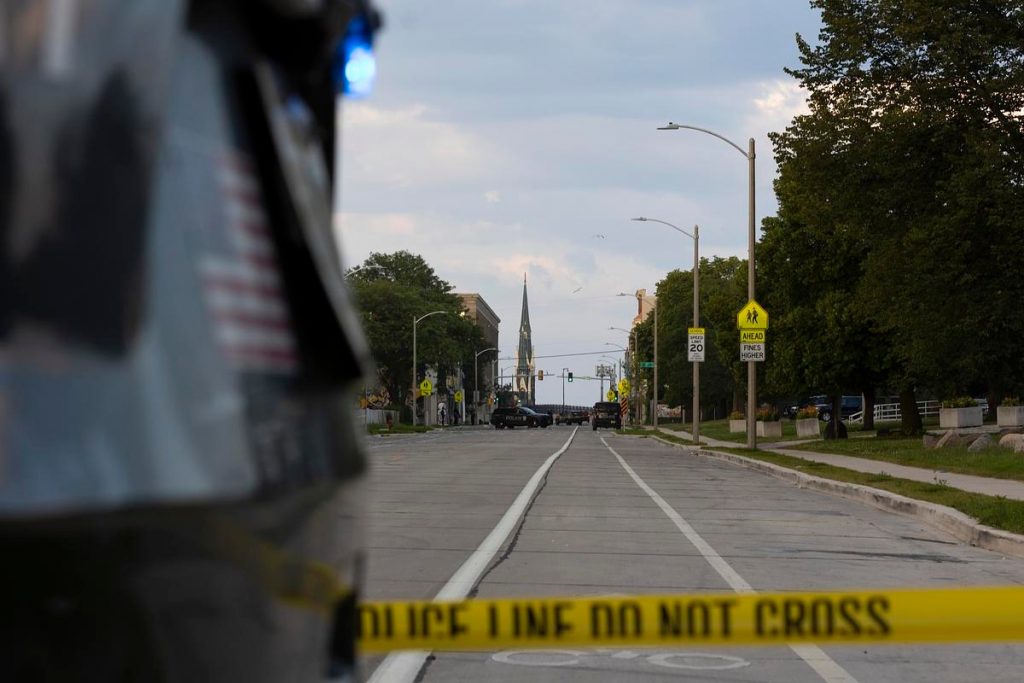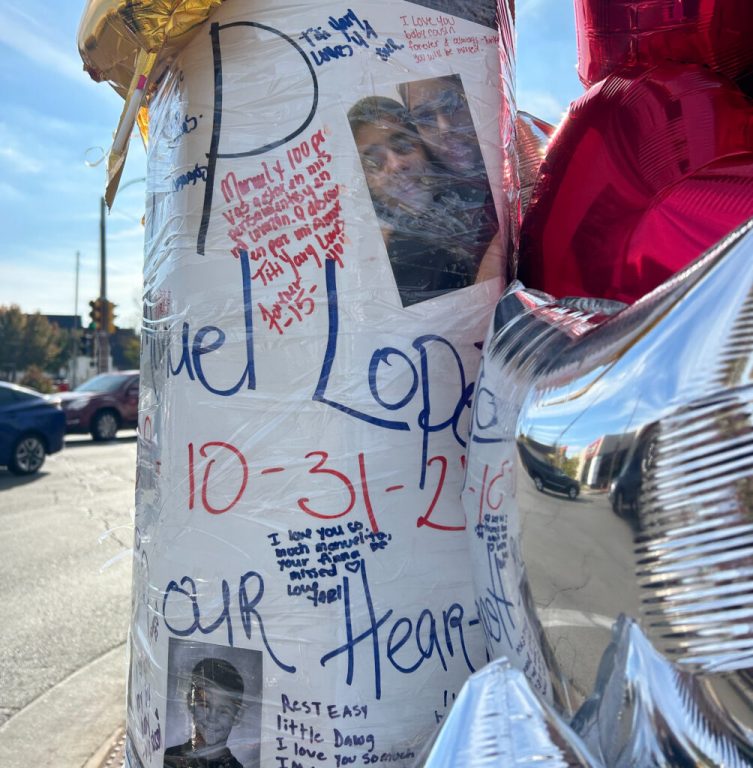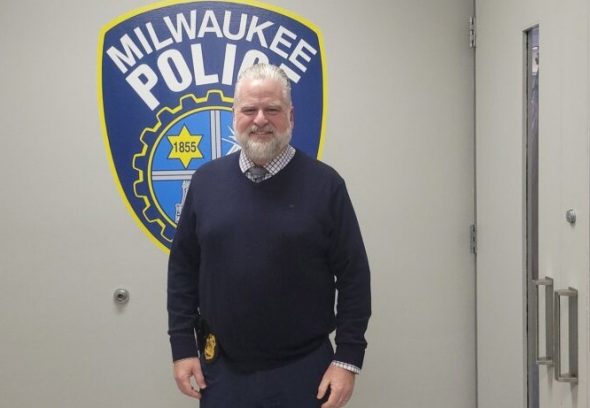Inside Milwaukee’s Homicide Investigations
Milwaukee Police use different approach than any large city in America.

Police tape surrounds the perimeter of the site of a shooting death July 16, 2024, in Milwaukee. (Joe Timmerman / Wisconsin Watch)
When he leaves the office at the end of the week, James Hutchinson, captain of the Milwaukee Police Department’s Homicide Unit, can’t wait for Monday so he can get back to work solving murders.
“I could have retired six months ago,” he said. “But I know that the work we do really makes an impact on people’s lives.”
For those awaiting justice, Hutchinson said he wants them to know that his team of 33 investigators remains committed to solving their case.
“From the first two weeks to a month, or months or years down the line, we’re equally as committed to solving a murder as we were today.”
That work begins as soon as a homicide is reported, he said.
Homicide investigations in Milwaukee
Typically, said Hutchinson, uniformed officers are the first to arrive on the scene. They work to establish an incident command area, set parameters using police tape, control crowds and prevent any disruption of evidence.
Patrol officers are also the first to seek out witnesses and spot cameras.
Detectives are not far behind. As soon as a homicide is reported, Hutchinson said, a team of detectives and supervisors will immediately head to the scene and start their investigation.
Once they arrive, they assemble the information that’s already been collected, gather more clues, find additional witnesses and hopefully identify suspects. Investigations take place in homes, city streets and hospitals or even at the medical examiner’s office.
Critical, Hutchinson said, is the early stages of that investigation.
“Those first moments, those first hours, those first minutes are very important. Evidence starts to disappear. People go to different places. It could be as simple as video evidence being recorded over. We focus and attack an investigation very fast, very intensively,” he said.
When homicides happen in bunches, as was often the case during the pandemic, resources are pulled from other units to help.

Friends and family of Nelson Manuel Lopez Correa, a 15-year-old boy who was shot and killed on Milwaukee’s South Side, created a memorial in his honor. (Edgar Mendez / Milwaukee Neighborhood News Service)
The team approach
Hutchinson said MPD investigates homicides differently from any other large city in America, using a team approach rather than dedicating detectives to specific cases. Homicide investigators working that shift will begin the investigation and then debrief the next shift before handing off the case.
Utilizing this method allows for a continuous investigation, but it also creates some problems, acknowledges Hutchinson.
“Because there is this team concept, you have a potential for having not as much accountability per person,” he said.
He said his division works to alleviate that problem by relying on sergeants and others, including himself, to oversee investigations and follow-ups.
Communication challenges
Another issue with not dedicating specific investigators to specific cases is communication.
“We love to get information, but we are not good at checking back in with the family and letting them know we haven’t forgotten,” he said. “We acknowledge that we have room for improvement.”
Not receiving regular updates from homicide investigators is a common complaint among family members of victims, especially those whose cases remain unsolved.
Brenda Hines, whose son Donovan was murdered in 2017, tracked down officers in person when they wouldn’t respond to her calls.
“It’s a bad process,” she said.
She founded the Donovan Hines Foundation in honor of her son and to help other families by providing grief support, mental health and other resources to residents.
Hines said she believes police can still solve her son’s murder if anything should come up.
Janice Gorden, who created Victims of Milwaukee Violence to help families access funeral support and other services, said she believes police are doing what they can to solve homicides and work with families.
But families, she said, will not be satisfied until they have answers. Often it gets to the point where they become focused on investigating the case themselves.
“They have way more information than sometimes the detectives do,” Gorden said. “They drive themselves crazy trying to find answers to who killed their loved one.”
Both Hines and Gorden have worked with mothers to arrange meetings with police and the district attorney’s office to get information about homicide cases.
Hutchinson said two new victim support positions were created recently to help improve communication with families.
Notifying the family
Hutchinson worked his way up the ranks of MPD, first as a patrol officer, then gang squad, detective, robbery and vice squad, and as a homicide detective from 2008 to 2020.

James Hutchinson became captain of MPD’s Homicide Division in 2020. (Edgar Mendez / Milwaukee Neighborhood News Service)
Before becoming captain, he has often taken on the grim task of letting a family member know a loved one was killed.
“Making a death notification is one of the hardest parts of this job. It’s incredibly heartbreaking,” he said. “The range of reactions, you can’t even anticipate. There are completely stoic people that accept what you’re telling them, to some incredibly violent reactions.”
A much better feeling, he said, is when they are able to notify a family that an arrest has been made. But even that’s a struggle.
From investigation to charges
Although police might make an arrest in a homicide case, that doesn’t mean that charges will be filed.
Police, Hutchinson said, only need probable cause to make an arrest. The burden of proof at the district attorney’s office, which files homicide charges, is higher.
“The DA’s office has to be able to prove it beyond a reasonable doubt,” he said. “Many times we will make an arrest for probable cause, but we can’t get to that level.”
What often happens, Hutchinson said, is that officers will bring a case to the DA’s office or discuss what evidence they have and then talk about whether more is needed to file charges.
While that does bring some frustration, admits Hutchinson, it’s better than arresting the wrong person.
Milwaukee County District Attorney Kent Lovern acknowledges that the work to hold someone accountable for murder can be burdensome on families seeking justice.
“Obviously, there is a significant gap between the evidence needed to make an arrest versus the evidence needed to successfully prosecute a case,” Lovern said.
The reason for caution and continued dialogue with officers in hopes of building a strong case is because there’s no room for error.
“We really have one opportunity with a particular suspect to bring forward charges and we want to get it right. Not only for the person charged, but the victim’s family and the integrity of the system,” he said.
‘We never forget about the victims’
Depending on the time of year and other circumstances, homicide investigation units can get extremely busy, Hutchinson said. Even when pulling resources from other units, it can still impact the amount of time investigators have for each case.
On the flip side, he said, sometimes they’ve hit the point where they don’t have anything left to do at the moment. But, he said, he wants families to know that victims are more than just a name to them.
“They are someone’s family member or friend, and the day they died is probably the worst day of many people’s lives,” he said.
Whether it’s been days, months or years, he wants family members to know his unit remains committed to solving their murder.
“Everyone can be assured that we never forget about the victims,” he said. “There is no replacement for their loved one, but it feels great to be able to notify the family that we have made an arrest.”
How you can help
Anyone with information on homicides is asked to contact Milwaukee police at 414-935-7360, or to remain anonymous, contact Crime Stoppers at 414- 224-TIPS.
This article first appeared on Wisconsin Watch and is republished here under a Creative Commons Attribution-NoDerivatives 4.0 International License.![]()
If you think stories like this are important, become a member of Urban Milwaukee and help support real, independent journalism. Plus you get some cool added benefits.





















“set parameters” should be “set perimeters”
pErImeters, not pArAmeters. Spell check is not grammar check.